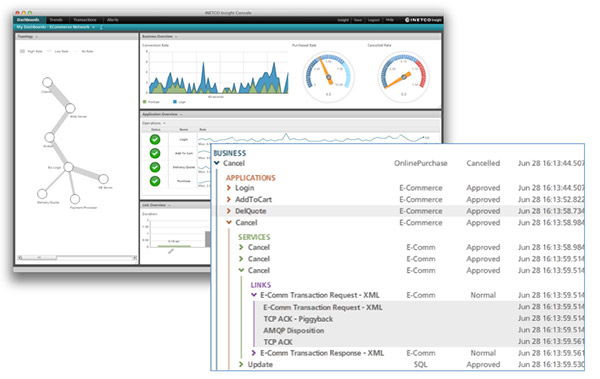I recently moderated a webinar where Loki Jorgenson, a technical advisor to INETCO, did an outstanding job of answering this question.
The take-away goods:
- According to a report published by Quocirca in February 2012, 43% of IT executives surveyed do not believe they have adequate APM tools. 82% were specific that they required a response time framing of APM, while 90% of them voiced a requirement of enterprise-wide, end-to-end visibility.
- According to a recent report by Trac Research comparing infrastructure approaches to transactional approaches – 81% of companies still focus on infrastructure reports, with only 39% adopting application transaction views on application performance. Yet times to resolve issues arising in multi-tiered application environments took 112 minutes on average using an infrastructure approach to solve the problem, compared to 31 minutes for a transactional approach.
These figures indicate that transaction-based application performance monitoring (APM) is becoming more essential – but they also indicate wide-spread adoption is still in the works and companies are taking their time. Can they afford to?
Let’s take a moment to examine some of the main trends driving rapid change in the application performance monitoring space:
- Growing complexity of distributed applications – brought on by the move towards virtualization, the Cloud, an increasing number of third party services and more customer facing applications
- The diversity within the application “ecology” – which in many cases is a mixture of custom-built applications, existing legacy apps, IaaS/PaaS/SaaS, a growing community of third party Cloud-based apps, and emerging mobile, social and location-based apps
- The speed of change and development – being driven by increasing customer demands, Agile Software Development, and more application development frameworks than ever before
It is not surprising that all this change is hindering the performance visibility of IT operations:
- Third party services cannot be easily instrumented
- Constructing end-to-end views is more difficult than ever before
- Abstraction from virtualization and the cloud obscures traditional infrastructure management tools
- There is limited, fragmented access to end user experience metrics
So what about key costs to the business? This change is also having a direct impact on operational efficiency, customer experience and revenues due to:
- Increased time-to-resolve bugs and breaks
- Inefficient management and optimization of resources
- Ineffective use of teams due to lack of coordination
We are also seeing application performance monitoring solution providers going through a huge “transition” to meet emerging requirements. There are new APM tools and new IT teams (operations to be precise) using these tools. Depending on what part of the application environment you are interested in, most APM solutions can now be categorized into a development or operational bucket:
- APM development tools are used to monitor code quality and optimization. They are for developers that want to “instrument” or “decorate” their code in order to follow their executed code all the way across an application. Quite often, these are specific to a particular environment such as Java or .Net
- APM operational tools are used to monitor response times and service quality. They provide information about how the application performs within a production environment, and build on a response time approach (versus infrastructure) to see how the end user is affected by changes. These tools take performance monitoring visibility enterprise-wide, and consider the performance impacts of third party service environments, Clouds, virtualization, network infrastructure, and operational contexts such as concurrency of accesses, load and effects of breaks.
Transaction-based application performance monitoring is considered an APM operations tool. These tools help IT operations teams gain access to response times and end user experience (EUE) metrics that reflect closely on service level delivery. IT ops teams used to be focused on infrastructure and devices. They used to be very much about resource utilization, and that is what many traditional APM tools provided. They could not achieve an enterprise-wide, end-to-end view, as this was difficult to assemble from resource utilization use. But as they continue to shift focus from how resources are consumed to what the customer is experiencing adopting the next generation of APM tools that enable them to monitor response times across the entire production environment will definitely become a more important priority.
For more information, download the “Who Owns the End-to-End Transaction” whitepaper or watch this on-demand webinar.


